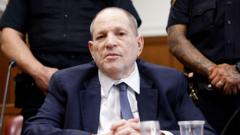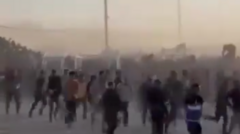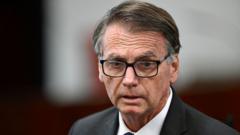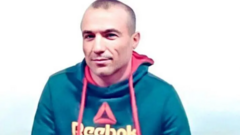**This groundbreaking war crime trial highlights the complexities of justice amid ongoing conflict.**
**Historic Trial of Russian Soldier Begins Over Alleged Execution in Ukraine**

**Historic Trial of Russian Soldier Begins Over Alleged Execution in Ukraine**
**Dmitriy Kurashov faces unprecedented prosecution for killing a captured Ukrainian soldier during wartime.**
In a landmark event within the ongoing conflict in Ukraine, the trial of Russian soldier Dmitriy Kurashov is set to redefine the accountability for war crimes in warfare. This case marks the first of its kind in Ukraine, as Kurashov is accused of executing Ukrainian soldier Vitalii Hodniuk, known by his callsign "Penguin," who was attempting to surrender during a chaotic battlefield incident. As January 2025 unfolds in the frigid frontline of Zaporizhzhia, the trial unveils the tragic consequences of war and the challenge of establishing justice within a fractured legal landscape.
On the chilly battleground, where remnants of past combat lay heavy with the weight of grief, Hodniuk's demise sparked an extensive investigation into war crimes committed by Russian forces. According to Ukrainian officials, Kurashov's trial comes amidst reports of at least 124 executions of prisoners of war by Russian troops since the full-scale invasion began. Unlike most cases that often remain unprosecuted, Kurashov stands alone, facing witnesses that include three of his former unit members willing to testify against him.
As Ukrainian prosecutors detail Kurashov’s alleged crime of shooting Hodniuk in cold blood, several layers of complexity envelop the proceedings. The courtroom conditions serve not only as a place of judgment but also as a microcosm of the war's chaos. As the prosecutor reads chilling accounts of battlefield executions, Kurashov's resolve seems to falter—initially pleading not guilty but ultimately shifting to a guilty plea, reportedly to expedite the trial.
With the international spotlight cast upon the courtroom, the specter of past grievances amongst the witnesses emerges, stirring concerns about the reliability of testimonies from captured soldiers—each with their unique narratives shaped by the trials of war. Yet, the commitment to bring justice resonates within the Ukrainian legal framework despite the challenges posed by the conflict itself.
Witnesses have recounted the moment leading to Hodniuk's demise, claiming that he complied with Kurashov's demands to surrender, only to meet an untimely end. Amidst the testimonies, Kurashov defends himself, pointing to another soldier as the alleged perpetrator of the shooting. As the trial unfolds, it surfaces the difficult balance between wartime loyalties and international laws that govern armed conflict.
With a history of troubling directives regarding treatment of prisoners, the Russian soldier’s account sheds light on the dire circumstances many combatants face—caught in a system that prioritizes aggressive tactics over humanity. Delving into Kurashov’s background reveals a narrative shaped by tragedy, imprisonment, and abandonment, amplifying the complexity of attaching moral accountability in a war-torn society.
As the legal proceedings continue, the broad implications of Kurashov's trial echo beyond the courtroom, holding the potential to challenge perceptions around accountability, warfare, and the tragic fates of those caught in the crossfire of conflict. For Hodniuk’s family, the quest for justice is a testament to loss, resilience, and the enduring hope that peace may one day restore what has been irrevocably broken. The trial remains ongoing, as both sides prepare for what may become a pivotal moment in the history of justice within the scope of modern warfare.
On the chilly battleground, where remnants of past combat lay heavy with the weight of grief, Hodniuk's demise sparked an extensive investigation into war crimes committed by Russian forces. According to Ukrainian officials, Kurashov's trial comes amidst reports of at least 124 executions of prisoners of war by Russian troops since the full-scale invasion began. Unlike most cases that often remain unprosecuted, Kurashov stands alone, facing witnesses that include three of his former unit members willing to testify against him.
As Ukrainian prosecutors detail Kurashov’s alleged crime of shooting Hodniuk in cold blood, several layers of complexity envelop the proceedings. The courtroom conditions serve not only as a place of judgment but also as a microcosm of the war's chaos. As the prosecutor reads chilling accounts of battlefield executions, Kurashov's resolve seems to falter—initially pleading not guilty but ultimately shifting to a guilty plea, reportedly to expedite the trial.
With the international spotlight cast upon the courtroom, the specter of past grievances amongst the witnesses emerges, stirring concerns about the reliability of testimonies from captured soldiers—each with their unique narratives shaped by the trials of war. Yet, the commitment to bring justice resonates within the Ukrainian legal framework despite the challenges posed by the conflict itself.
Witnesses have recounted the moment leading to Hodniuk's demise, claiming that he complied with Kurashov's demands to surrender, only to meet an untimely end. Amidst the testimonies, Kurashov defends himself, pointing to another soldier as the alleged perpetrator of the shooting. As the trial unfolds, it surfaces the difficult balance between wartime loyalties and international laws that govern armed conflict.
With a history of troubling directives regarding treatment of prisoners, the Russian soldier’s account sheds light on the dire circumstances many combatants face—caught in a system that prioritizes aggressive tactics over humanity. Delving into Kurashov’s background reveals a narrative shaped by tragedy, imprisonment, and abandonment, amplifying the complexity of attaching moral accountability in a war-torn society.
As the legal proceedings continue, the broad implications of Kurashov's trial echo beyond the courtroom, holding the potential to challenge perceptions around accountability, warfare, and the tragic fates of those caught in the crossfire of conflict. For Hodniuk’s family, the quest for justice is a testament to loss, resilience, and the enduring hope that peace may one day restore what has been irrevocably broken. The trial remains ongoing, as both sides prepare for what may become a pivotal moment in the history of justice within the scope of modern warfare.


















